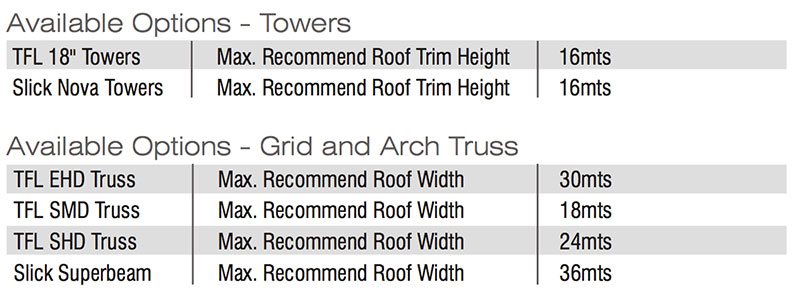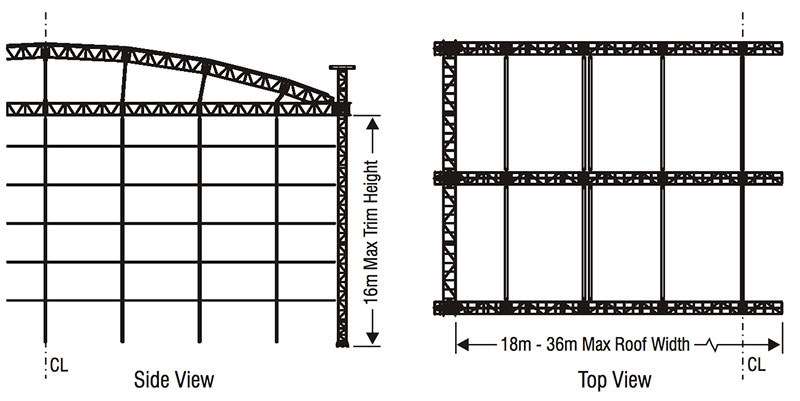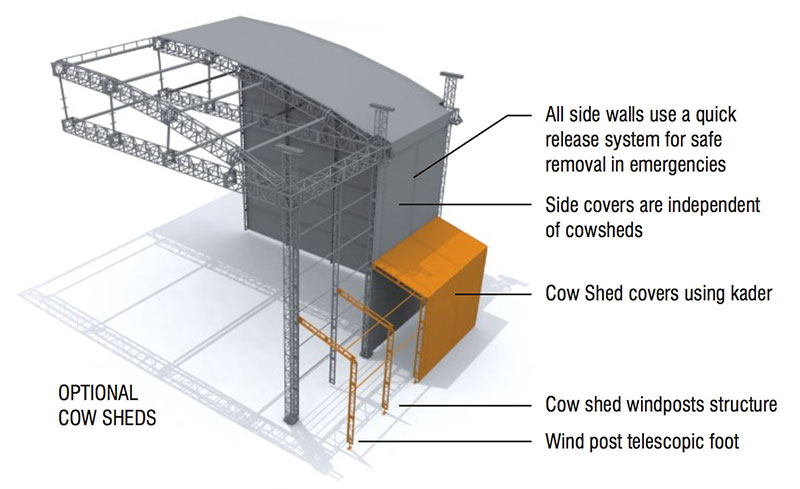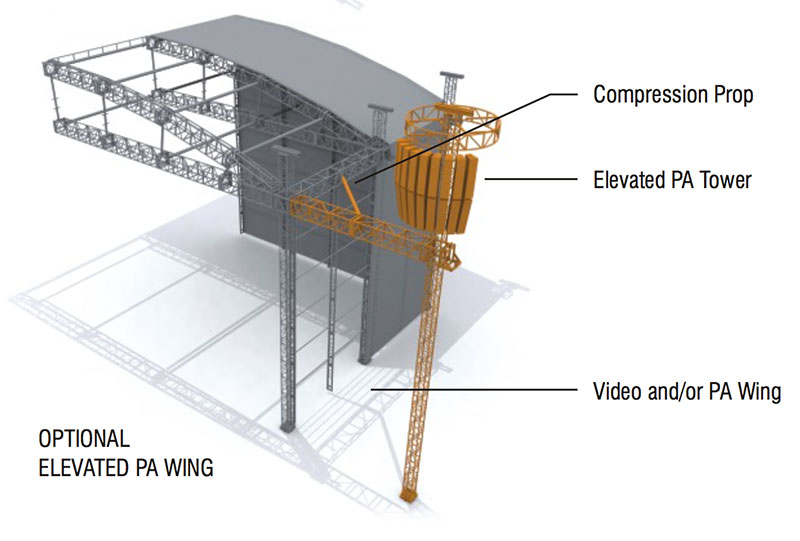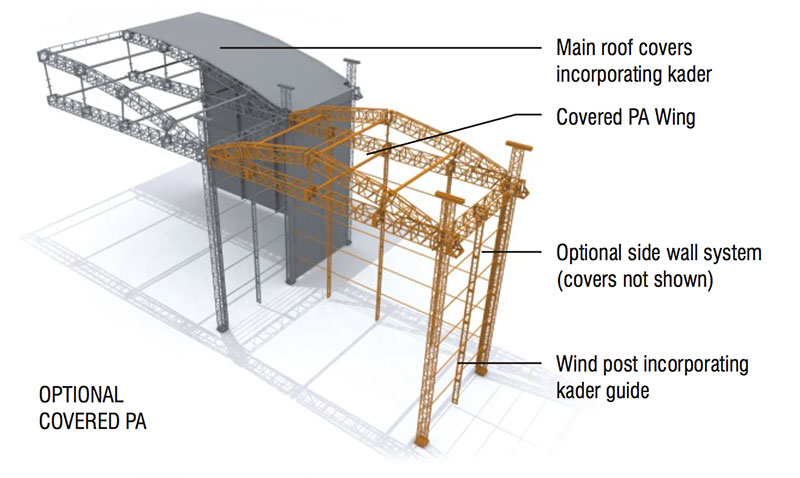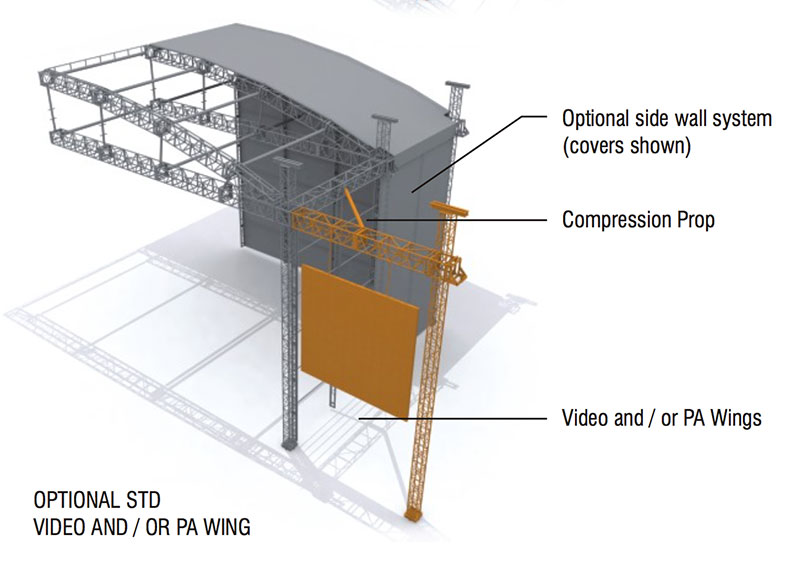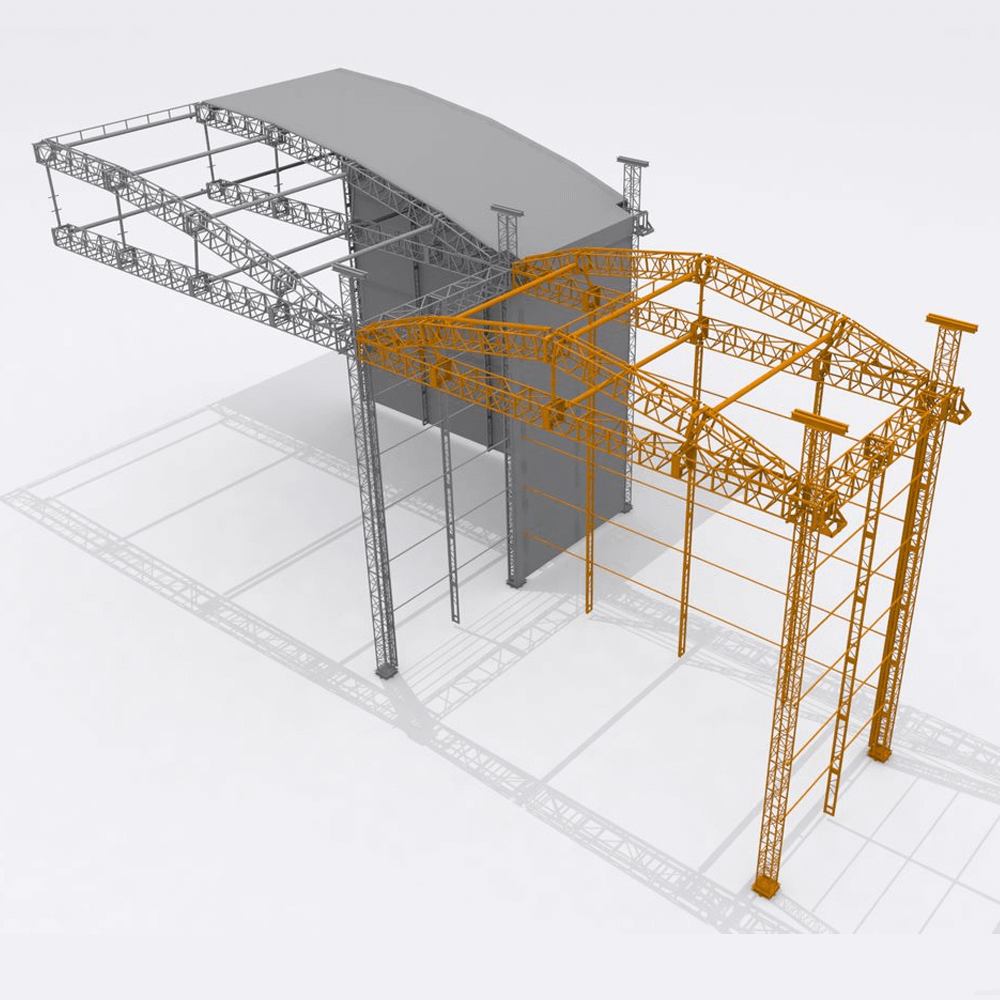
Compound Arch Outdoor Roof
Compound Arch Outdoor Roof
Compound Roof Systems are an evolution of using two sets of truss elements to create the capacity of one much larger unit. By combining a flat grid truss with a structurally tied arched truss, these systems achieve much longer spans while maintaining large loading capacities. Each compound arch is connected to the next using a series of tubular purlins, ensuring stability and strength across the structure.
A significant advantage of Compound Roof Systems is the use of mostly standard trusses, with special components being relatively small sections. This design choice not only enhances the structural integrity but also allows for an extremely tight truck pack, making transportation and setup more efficient.
Longer Spans
The ability to achieve longer spans without compromising the loading capacity is particularly beneficial for large-scale events, where the demand for extensive stage coverage and robust support is paramount. Additionally, the modular nature of these systems provides flexibility in accommodating various stage configurations and adapting to different event requirements.
Moreover, the implementation of Compound Roof Systems ensures that the structures are weather-resistant, capable of withstanding environmental elements, and providing reliable shelter for event equipment and attendees. The integration of both flat and arched trusses results in a versatile solution that meets the demands of modern event staging, offering both durability and efficiency.
Overall,
Compound Roof Systems represent a significant advancement in event staging technology, combining innovative design with practical benefits to deliver an unparalleled experience for both organizers and audiences.
Features at a glance
Nominal 10,000 - 40,000 kg's
Conical and tapered
Extreme Coverage for Outdoor Events
An Compound Arch roof system covers a stage to protect sound systems and lighting equipment during outdoor events, ensuring both equipment and performers stay shielded from the elements. Ideal for festivals, gigs, charity events, and drama productions, these systems offer a professional balance of functionality and aesthetics. Perfect for larger festivals these stage roof systems can be customized to fit specific needs and budgets. Compound Roofing Systems take you standard truss and apply it in an innovative way to create ever large spans.
Do I Need a Stage Roof System?
If you’re planning an outdoor event, a stage roof system is practically indispensable. Here’s why:
- Weather Protection: Outdoor events are often subject to unpredictable weather conditions. A front peak roofing system shields your event from rain, wind, and intense sunshine, crucial factors to consider especially in regions like the UK.
- Equipment Safety: With a protective covering overhead, key elements such as sound and lighting equipment are safeguarded against any adverse weather conditions. This not only prolongs the life of your gear but also ensures that your event runs smoothly without technical glitches.
- Performer Comfort: A comfortable performer delivers a better show. By providing shade and shelter, an outdoor roof helps keep performers at ease, allowing them to focus entirely on their craft.
- Enhanced Acoustics: The right stage roof can improve sound quality by directing sound appropriately across the venue. This acoustical advantage can make a significant difference in how the audience experiences the performance.
- Visual Focus: Beyond practical benefits, a stage roof also acts as a centrepiece for your event, naturally drawing the audience’s attention and anchoring the space visually.
In essence, a stage roof system is not just a sensible investment; it ensures the safety, quality, and overall success of your outdoor event.
Choosing the Right Stage Roof System Size
Selecting the perfect outdoor stage size depends on several key factors. Here’s a guide to help you make the best choice:
- Stage Dimensions: First, measure the stage dimensions that need coverage. This will significantly influence the size of the roof system you should consider.
- Common Sizes: Popular stage roof sizes include options like 12x8m, 15×10 and 18x12m, typically reaching a height of around 14m. These dimensions are versatile and cater to a variety of events and stage types.
- Event Type and Requirements: Consider the nature of the event. Will there be large-scale performances requiring additional equipment? Bigger stages often need larger and sturdier roof systems to accommodate lighting and sound equipment.
- Customization Options: If standard sizes don’t meet your needs, many suppliers offer custom-built roof systems. Custom solutions ensure that unique stage setups and specific environmental conditions are perfectly addressed.
- Safety and Regulations: Ensure the chosen roof system complies with local safety standards and regulations. This is crucial for the safety of performers and the audience alike.
- Consulting Professionals: Consult with stage equipment professionals or suppliers who can provide expert advice tailored to your event’s specific needs.
By evaluating these factors and considering your event’s unique circumstances, you can select a stage roof system that will provide the appropriate coverage and functionality.
How Much Does a Stage Roof System Cost?
When planning an event, understanding the cost of a stage roof system is crucial. Prices can vary widely, primarily based on the size, type, and complexity of the system you need.
- Lightweight Truss Systems: Offering more support and flexibility, these roof systems are generally based around 30 or 40 cm truss sizes. These tend to be at the lower end in pricing but are perfect for those pop-up shows, a small festival stage roof or community spaces in towns and cities. They require minimal set up equipment and generally require low levels of working from height if not at all. Our Lite Stage Systems would fall into this category.
- Self-Climbing Medium Systems: These generally use larger trusses to be able to span to about 15mts wide with trim heights of 12mts, but can still be classed as a compact roof system. You are looking at capacities about 3 to 5 tonnes on the main grid. PA and Video wings can be added. These systems have an extra layer of complexity to the lightweight pop-up systems, normally involving chain hoists, control and significant working at height. Typical Truss systems that might be used are 40, 50 and 60cm trusses. Configurations are mainly Pitched or Front Peaked style but could be arched also.
- Complex Systems: For large events or unique setups, more complex systems are available. These can include Compound, Front Peaked, Pitched, Arched or even Hydraulic. These systems will give the client unparalleled flexibility, load capacity and size but these will definitely be on the higher end of the pricing spectrum. Typical truss sizes being used here would be anything from 60cm to 180cm. Overall spans would typically range from 18mt to anything up to 75mt.
Compound Arch Outdoor Roof Systems.
Compound Arch Roofing Systems are elegant and lightweight structures ideally suited for medium festivals and events. There unique design can offer large areas of branding, which can nicely appeal to venue organisers and sponsors alike. The system systems effectively use aluminium trussing like the main cords of a larger truss, significantly expanding its ability to span larger distances with enhanced loading.
Important notes on what to consider on how to Install a Festival Stage.
Assembling stage and truss is a straightforward process when handled by a competent crew. Outdoor Roof systems should always be accompanied by a structural report and corresponding RAMS for construction and use.
- Local Regulations; Ensure you know what you have to comply with. In the UK there is the temporary Demountable Structures document. This is also considered best practice in many other parts of the world and is generally a great document to read. You can find this information here.
- Ground Conditions: Ensure you know what you are building on. Being on grass is very different to concrete.
- Load Capacity: Ensure that the aluminium trussing system you use has a high comparative load capacity to support lighting, speakers, and other equipment safely.
- Weather Conditions: Temporary structures like a festival stage roof need to be stable under varied weather conditions.
- Safety Considerations: Proper assembly and disassembly are critical to prevent collapse or instability. Ensure all parts are securely attached and the structure is level for safe use.
- Secure with Ballast or Ground Anchors: Ensure the stage roof system is properly secured with appropriate ballast or ground anchors to withstand various environmental conditions. Note, the coefficient of friction changes depending on ground type and conditions so your ballast needs have to be reviewed on a site by site basis.
- Wind Management Plans: These are an integral part of Outdoor Stage building. You have to know what actions you need to take at which wind speeds which may include cancelling the show.
Compliance
Our UK manufacturing processes include compliance with:
-
- BS EN 1090-3:2008: Technical Requirements for aluminium structures
- EN ISO 9001:2008: Quality management systems ensuring consistent quality across all products
- BS EN 1999 Pt 1-1 : Design of Aluminium Structures, General structural rules
- BS EN 17115:2018: Specifications for the design and manufacture of aluminium and steel trusses
Frequent Use.
You also have the peace of mind that these loading charts have been calculated to EN17115 in order to ensure that your lighting framework remains fit for purpose even after a few scratches and dents. What is the Frequent Use Factor?

